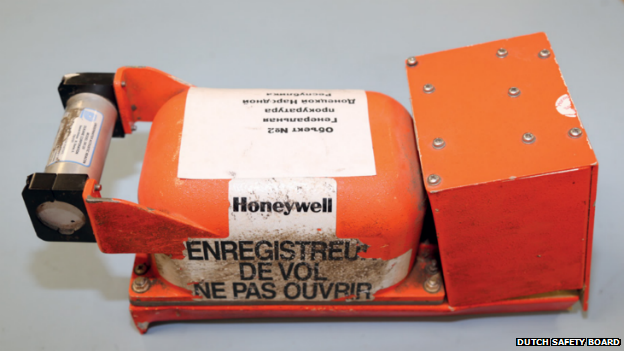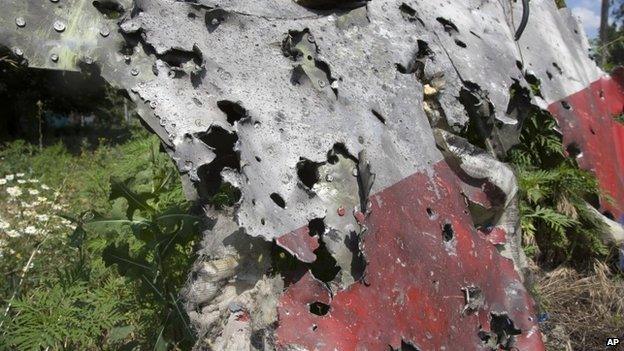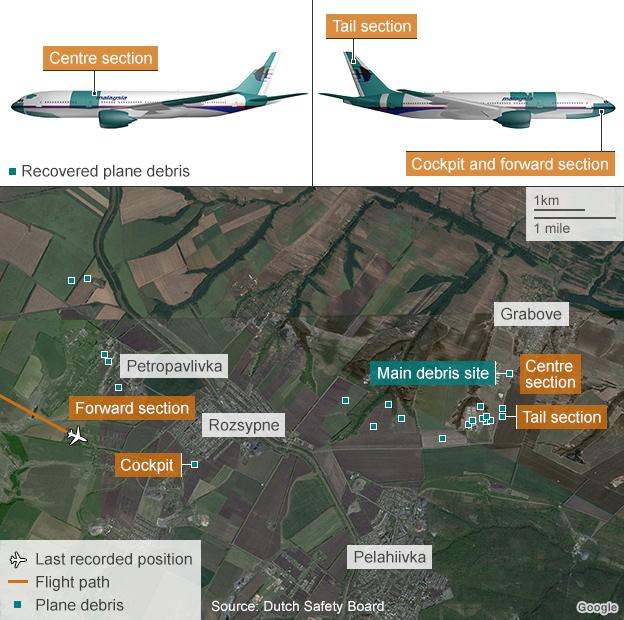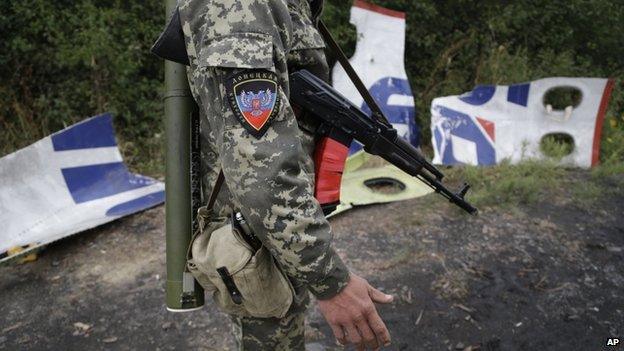MH17 crash: Dutch experts say numerous objects hit plane
- Published
Footage on Tuesday shows rebels roaming amongst the MH17 wreckage, as Nomia Iqbal reports
Dutch experts say Malaysia Airlines flight MH17 broke up in mid-air after being hit by "objects" that "pierced the plane at high velocity" in July.
The new report, external also said there was "no evidence of technical or human error".
Correspondents say this matches claims that MH17 was hit by missile shrapnel.
Investigators relied on cockpit data, air traffic control and images, as the crash site in eastern Ukraine remains too dangerous to access amid fighting between government troops and rebels.
The plane was flying from Amsterdam to Kuala Lumpur when it crashed in rebel-held territory in eastern Ukraine.
All 298 people on board, most of them from the Netherlands, died when the plane came down, amid reports it was shot down by pro-Russian rebels.
The BBC's Anna Holligan reports takes a close-up look at one of the first copies of the report
The report made no comment on who might have fired the missile.
Both sides in this conflict use the same weapon, reports the BBC's transport correspondent Richard Westcott, and to find out who was responsible investigators would need to determine where the missile was launched.

Investigators say the cockpit voice recorder "gave no indication that there was anything abnormal" on board

The Dutch team analysed photographs of the wreckage that showed a number of pieces with multiple holes
One expert said they should eventually be able to work that out with a combination of radar data and evidence from the scene, our correspondent reports.
A sobering fact highlighted in this report was that three other, very large commercial airliners flew over the same area at around the same time, he adds.
The report from Dutch experts says the plane "broke up in the air probably as the result of structural damage caused by a large number of high-velocity objects that penetrated the aircraft from outside".
The investigators have not visited the crash site because of fighting in the area but they said photographic evidence of the wreckage suggests the plane split into pieces during "an in-flight break up".
Satellite image of MH17 debris site

Maintenance history showed the aircraft was airworthy and had no known technical problems when it took off from Amsterdam, the report added.
Experts said it was manned by "a qualified and experienced crew" and that engines were running normally at a speed of 915km/h (567mph) at 33,000ft (cruise altitude).
Radio communications between the pilot and Ukrainian air traffic control confirm that no emergency call was made.

Final transmissions from MH17
At 13:08:00 MH17 contacts Ukraine's Dnipropetrovsk International Airport (DNP):
MH17 to DNP: Dnipro Radar, Malaysian one seven, flight level 330
DNP to MH17: Malaysian one seven, Dnipro Radar, good day, radar contact
Flight MH17's last transmission was at 13:19:56 when it responded to a navigation request from DNP:
DNP to MH17: Malaysian one seven, due traffic proceed direct to point Romeo November Delta
MH17 to DNP: Romeo November Delta, Malaysian one seven
At 13:20:00, DNP sends MH17 another radar message but there is no response:
DNP to MH17: Malaysian one seven, how do you read me? Malaysian one seven, Dnipro Radar
DNP makes two more requests for contact from MH17 before Russia's Rostov airport (RST) calls in at 13:22:05.
RST to DNP: Listening [to] you, its Rostov
DNP to RST: Rostov, do you observe the Malaysian by... by the response?
RST to DNP: No, it seems that its target started falling apart.

Criminal investigation
While it is not the final report into the crash, the findings are significant because they are the first official account of what happened, says the BBC's Anna Holligan in the Netherlands.
A separate criminal investigation is being conducted by prosecutors in The Hague, she adds.
Dutch Safety Board Chairman, Tjibbe Joustra, says experts will now try to reconstruct how MH17 came down
Barry Sweeney, whose son Liam died on board flight MH17, told the BBC it was "comforting... to know that nobody suffered" given the speed of the plane's break-up.
"It doesn't really matter who's done it, because they're still dead. If we find out, so be it. Unfortunately we can't do anything about it and we've just got to move on," he said.
Samira Calehr, a Dutch mother who lost two sons in the crash, told AP she wanted those responsible brought to justice "as soon as possible".
"I want to know who killed my children," she said.

The Russian government denies delivering arms to the separatists
Malaysian Prime Minister Najib Razak welcomed the report, saying it "leads to the strong suspicion that a surface-to-air missile brought MH17 down".
The rebel leader of the self-proclaimed Donetsk People's Republic, Aleksandr Zakharchenko, told the Russian Interfax news agency that the separatists did not have the capability to shoot down the plane.
Ukraine's government and several Western leaders say there is strong evidence that pro-Russian separatists shot down the plane with an anti-aircraft system known as Buk.
Russia has consistently denied allegations that it had supplied any missiles or weapons to the rebels.
The search for evidence has been hampered by heavy fighting in the region, and Malaysian Transport Minister Liow Tiong Lai called on both sides to grant investigators full access.
More than 2,600 people have been killed and thousands more wounded since violence between rebels and Ukrainian government forces erupted in April.


Key findings of report
Likely that damage resulted in loss of structural integrity of aircraft, leading to break-up in the air
Forward parts of plane found near Petropavlivka closest to last flight data broadcast
Cockpit window contained numerous small puncture holes suggesting small objects entered from above level of cockpit floor
Damage to forward section indicates plane penetrated by large number of high-velocity objects from outside
No evidence found of manipulation of flight and data recorders
No indication of technical or operational issues with plane or crew